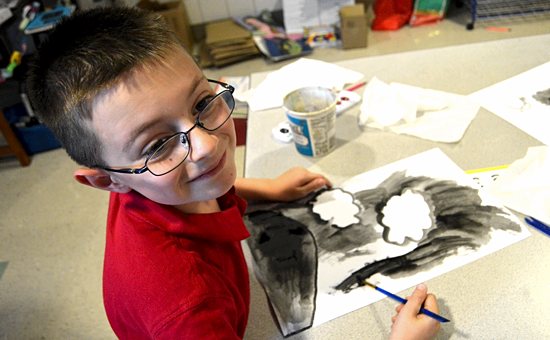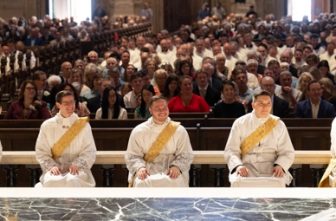
It’s like a scene from a futuristic movie.
In a grade-school classroom, students work at “pods,” odd-shaped work stations that take on the look of islands, each with three peninsulas. Each peninsula hosts a large, glistening computer monitor, and pods share some of the newest technology available.
It’s the Smart Lab at St. Joseph Catholic School in Waconia, a town of 11,500 some 35 miles west of Minneapolis that is transitioning from a rural area to an outlying suburb.
It’s where teacher Amy Gallus “facilitates the learning” on a wide range of projects. She takes a hands-on, inquiry-based approach that’s part of the school’s new STEM program, which focuses on science, technology, engineering and math.
“It’s an awesome environment,” Gallus said. “It’s so great seeing kids so alive and having fun learning.”
St. Joseph, however, has added a “C” before the STEM — for Catholic — making the school an environment for integrating faith into lessons as well.
“One of the criteria for each stage is defining how I’m a better Christian, a better Catholic, by doing this project,” added Gallus, who is St. Joseph’s C-STEM curriculum specialist. “They’re picking it up right away.”

Enrollment rising again
The STEM initiative was something recommended by Jill Riley, the now retired superintendent of the former Office of Catholic Schools of the Archdiocese of St. Paul and Minneapolis, recalled Bruce Richards, St. Joseph’s principal.
Enrollment had been up to 380 students in the mid-2000s, but there had been a steady decline in recent years. The school has also had five principals in the past 10 years.
“We’ve experienced our first growth this year,” said Richards, who is beginning his third year at St. Joseph. An 8 percent increase brought the number of students to 151 in kindergarten through grade eight.
“We feel we’ve turned a corner,” Richards said.
Integrating C-STEM is part of that.
In order to add STEM certification to their teaching licenses, all St. Joseph faculty completed a 15-month set of graduate level STEM courses through St. Catherine University in St. Paul, home of the National Center for STEM Elementary.
Grants from the GHR Foundation and Speranza scholarships from St. Catherine made the STEM training affordable.
“Our teachers were curious, hungry and eager to do something transformative,” Richards said, “and they’ve made C-STEM work.”
Jay Olson teaches literature, math and what St. Joseph identifies as “faith,” an approach in which teachings of the Catholic Church and morals are discussed and identified in all content areas during the school day.
Working with fifth- and sixth-graders to help them understand “how to get the knowledge to stick,” as Olson put it, he watched as students in groups of twos and threes read to one another and then quizzed each other.
“It’s a process of hearing first,” Olson explained, “and moving toward logic and reason, memory and eventually knowledge.”
In working on critical thinking, he said, classes in the past have taken on contemporary topics, among them, the “hands up, don’t shoot” phrase of those alleging racially motivated abusive police actions. Students research the moral and ethical dilemmas and debate both sides of the issues.
“These are topics kids need to know about and get beyond the headlines,” Olson said. “They learn how to argue through persuasion, and they can say, ‘This is why I’m a Catholic.’”

Getting the word out
St. Joseph’s main challenge is marketing — telling the stories about what is happening at the school — Richards acknowledged.
“We haven’t done enough,” he said, adding that he relies on parents to spread the word.
St. Joseph does have an inspiring new video — thanks to student parent Paul David, owner of the video production company that carries his name.
While the video — at school.stjosephwaconia.org — tells St. Joseph’s story well, Richards said he’s hoping the newly formed Catholic Schools Center of Excellence will provide the marketing support necessary to help his school continue moving forward.
“We need someone to start to champion who we are,” he said.




